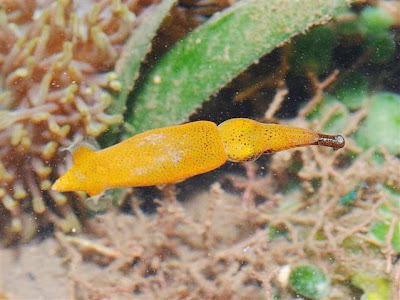Though it was a Sunny Sunday out at Southern Semakau (4S's), there was still quite a number of marine critters that we came across on this trip!
Above is a photo of a seagrass meadow with lots of Tape seagrass (Enhalus acoroides) found just right next to the mangroves.
The heat was on as the sun blazed at us on a not-so-low tide during the sargassum seaweed season. What can we find?
After we landed on the shore, Ivan quickly found this tiny weeny Spotted-tail frogfish (Lophiocharon trisignatus)! He was able to spot it as the fish was swimming around the tidal pool.
The team also found a couple of Bumpy cuttlefishes (Family Sepiidae) on the shore. These chubby cuttlefishes are usually more commonly seen at night.
Here's another baby cuttlefish that we saw on the shore though this is more pale than the previous one.
These Upsidedown jellyfish (Cassiopea sp.) are almost uniquely Semakau. Though there are records of these jellyfishes elsewhere, I myself have only seen it here at Semakau.
Here's another upsidedown jellyfish with their tentacles facing up because they contain photosynthetic algae to make food for the animal. How cool!
The food produced is shared with the jellyfish, which in return provides the algae with shelter and minerals. It is the algae which gives the jellyfish its colours.
Looking similar to the upsidedown jellyfish would be the Fire anemones (Actinodendron sp.) that are rather common on this part of Semakau. The oral disk has white stripes with small dark spots, radiating from the mouth. I think the stripes look very cool on the anemone!
Ivan and James saw a Dog-faced water snake (Cerberus rynchops)! We also encountered this snake when we visited the same shore in August.
When I first saw the feeding tentacles sticking out of the ground, I already knew that it belongs to a sea cucumber but couldn't confirm what it is before digging it out. Though initially I thought it was the Ball sea cucumber (Phyllophorus sp.), it was later found to be the Purple sea cucumber.
The Knobbly sea stars (Protoreaster nodosus) are still there and they seem to be doing well.
Chay Hoon found a special snail! This Sundial snail (Architectonica perspectiva) is said to eat burrowing sea anemones and sea pens. I can't really figure this guy doing that though. Haha!
The sargassum season made exploring the reef very tough and we are confident that many of them are hidden beneath the mats of seaweed that bloom during this season. Nevertheless, I still came across a good assortment of hard corals.
On this trip, I decided to have a closer look at the higher shores near to both the natural and replanted mangroves of Southern Semakau.
Some of the trees are really huge! Look at the trunk of this particular tree.
There are lots of marine life found smack next to or at the substrate of the mangrove habitats. I observed that there are many of these Tubular sponges (Haliclona sp.) found on the rocky parts of the mangrove.
A special find on the mangrove-y part of Semakau is this bright yellow Pygmy squid (Idiosepius sp.) swimming near a carpet anemone. Unfortunately, Ivan later shared with me that this squid was later stung by the anemone while it was swimming too close to it.
Out of a sudden, we felt that the whole shore darkened drastically. It was actually the sun hiding behind a huge cloud.
That kind of started the glorious sunset that accompanied the shore explorers for the rest of the trip!
I went deeper into the mangroves to see what lies out there. Would the assemblage of animals be very different?
I was pleasantly surprised to find quite a lot of the Yellow prickly branching sponges (Pseudoceratina purpurea) growing right next to the stilt roots of the replanted mangroves.
At the rocky areas, the Button zoanthids (Zoanthus sp.) are very abundant. They come in an amazing variety of colours and patterns.
Semakau is one of the few shores where many of these Giant carpet anemones (Stichodactyla gigantea) are found growing with the mangroves.
All too soon, it was time to leave after the sunset. Will miss this shore for the moment and hoping to revisit Semakau again. :)
More photos of the trip here: http://www.flickr.com/photos/koksheng/archives/date-taken/2013/10/06/































No comments:
Post a Comment